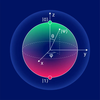
Bell States The Quantum Foundations of Entanglement
Bell states are four specific, maximally entangled two-qubit quantum states that exhibit non-classical correlations and are fundamental to quantum information science. They are used in applications like quantum teleportation and superdense coding, and can be visualized as pairs of qubits where measuring one instantly determines the state of the other, regardless of the distance between them
Among the purest and most studied manifestations of entanglement are the Bell States, named after physicist John S. Bell, whose 1964 theorem shook the foundations of classical physics.
Bell States are not just theoretical curiosities - they are the building blocks for quantum technologies such as quantum teleportation, superdense coding, and quantum key distribution (QKD). Understanding them is therefore essential for any serious student or practitioner of quantum information science. When one of the two qubits is measured, it takes on a specific value, and the second qubit is forced to also take on a specific value, as the entangled state collapses.
The four Bell states are a set of maximally entangled two-qubit states. They are written as:
\(|\beta_{00}\rangle = \frac{|00\rangle + |11\rangle}{\sqrt{2}}\)
\(|\beta_{01}\rangle = \frac{|01\rangle + |10\rangle}{\sqrt{2}}\)
\(|\beta_{10}\rangle = \frac{|00\rangle - |11\rangle}{\sqrt{2}}\)
\(|\beta_{11}\rangle = \frac{|01\rangle - |10\rangle}{\sqrt{2}}\)
These states form an orthonormal basis for the two-qubit Hilbert space, known as the Bell basis.
Of course. This is an excellent question because it gets to the heart of quantum entanglement. Let's break down each Bell state and then see how they are constructed.
The Big Picture: What are Bell States?
Bell states are the maximally entangled states for two qubits. "Maximally entangled" means that the two qubits are so perfectly correlated that you cannot describe one without instantly knowing something about the other, no matter how far apart they are. This is the "spooky action at a distance" that Einstein, Podolsky, and Rosen (EPR) pointed out, hence the name "EPR pairs."
- Detailed Explanation of Each State
We'll assume the standard computational basis: \(|0\rangle = \begin{bmatrix}1 \\ 0\end{bmatrix}\) and \(|1\rangle = \begin{bmatrix}0 \\ 1\end{bmatrix}\).
a) \(|\beta_{00}\rangle = \frac{|00\rangle + |11\rangle}{\sqrt{2}}\)
* Explanation: This is often the canonical example of entanglement.
* The state is a superposition of two possibilities: both qubits are 0 and both qubits are 1.
* If you measure the first qubit and find it in \(|0\rangle\), the entire state instantly collapses to \(|00\rangle\). The second qubit is now guaranteed to be \(|0\rangle\).
* Conversely, if you measure the first qubit and find it in \(|1\rangle\), the state collapses to \(|11\rangle\), and the second qubit is guaranteed to be \(|1\rangle\).
* Correlation: Perfect Positive Correlation . The measurement outcomes for both qubits will always be the same .
b) \(|\beta_{01}\rangle = \frac{|01\rangle + |10\rangle}{\sqrt{2}}\)
* Explanation: This is sometimes called the "anti-symmetric" or "singlet" state.
* It's a superposition of two possibilities: the first qubit is 0 and the second is 1 and the first qubit is 1 and the second is 0.
* If you measure the first qubit and find \(|0\rangle\), the state collapses to \(|01\rangle\), meaning the second qubit must be \(|1\rangle\).
* If you measure the first qubit and find \(|1\rangle\), the state collapses to \(|10\rangle\), meaning the second qubit must be \(|0\rangle\).
* Correlation: Perfect Negative Correlation / Anti-Correlation . The measurement outcomes for both qubits will always be opposite .
c) \(|\beta_{10}\rangle = \frac{|00\rangle - |11\rangle}{\sqrt{2}}\)
* Explanation: This state is very similar to \(|\beta_{00}\rangle\). The only difference is the "minus" sign, which represents a relative phase .
* The correlation is identical to \(|\beta_{00}\rangle\): measuring one qubit tells you the state of the other. If the first is 0, the second is 0; if the first is 1, the second is 1.
* The phase difference (- sign) becomes crucial when these states are used in quantum algorithms or when certain gates are applied. For simple measurement in the \(\{|0\rangle, |1\rangle\}\) basis, it behaves the same as \(|\beta_{00}\rangle\).
* Correlation: Perfect Positive Correlation (with a different phase).
d) \(|\beta_{11}\rangle = \frac{|01\rangle - |10\rangle}{\sqrt{2}}\)
* Explanation: This state is the phased version of \(|\beta_{01}\rangle\).
* The correlation is identical to \(|\beta_{01}\rangle\): the measurement outcomes are always opposite.
* This state is unique because it is invariant under collective rotation. It is the true "singlet" state.
* Correlation: Perfect Negative Correlation / Anti-Correlation (with a different phase).
- How Are These States Arrived At? (The Circuit)
All four Bell states can be generated from the four computational basis states (\(|00\rangle, |01\rangle, |10\rangle, |11\rangle\)) using a simple, standard quantum circuit.
NB:- superposition is the ability of a quantum system to be in multiple distinct states at the same time, until it is measured.
The circuit has two steps:
- Put the first qubit into a superposition.
- Use the state of the first qubit to control a operation on the second qubit.
Here is the quantum circuit that creates a Bell state from an initial state \(|ab\rangle\):
|a⟩ ───H───●───
|b⟩ ──────────X───
Gates Used:
* H : The Hadamard Gate. It creates superposition.
\( H|0\rangle = \frac{|0\rangle + |1\rangle}{\sqrt{2}} \)
\( H|1\rangle = \frac{|0\rangle - |1\rangle}{\sqrt{2}} \)
* X : The Pauli-X Gate (the quantum NOT gate).
\( X|0\rangle = |1\rangle \), \( X|1\rangle = |0\rangle \)
* ● : The Controlled-NOT (CNOT) Gate. It performs an X-gate on the target qubit (the second one) only if the control qubit (the first one) is \(|1\rangle\).
Step-by-Step Derivation of Bell's States
Let's see what happens for each initial state.
Case 1:Initial State \(|00\rangle\) → Final State \(|\beta_{00}\rangle\)
- Apply H to qubit 1:
\( H|0\rangle = \frac{|0\rangle + |1\rangle}{\sqrt{2}} \)
So the state becomes: \(\frac{|0\rangle + |1\rangle}{\sqrt{2}} \otimes |0\rangle = \frac{|00\rangle + |10\rangle}{\sqrt{2}}\)
- Apply CNOT:
* The term \(|00\rangle\): Control is \(|0\rangle\), so nothing happens to target. Stays as \(|00\rangle\).
* The term \(|10\rangle\): Control is \(|1\rangle\), so X is applied to target. \(|10\rangle\) becomes \(|11\rangle\).
* The state is now: \(\frac{|00\rangle + |11\rangle}{\sqrt{2}} = |\beta_{00}\rangle\)
Case 2: Initial State \(|01\rangle\) → Final State \(|\beta_{01}\rangle\)
- Apply H to qubit 1:
\( H|0\rangle = \frac{|0\rangle + |1\rangle}{\sqrt{2}} \)
So the state becomes: \(\frac{|0\rangle + |1\rangle}{\sqrt{2}} \otimes |1\rangle = \frac{|01\rangle + |11\rangle}{\sqrt{2}}\)
- Apply CNOT:
* The term \(|01\rangle\): Control is \(|0\rangle\), so nothing happens . Stays as \(|01\rangle\).
* The term \(|11\rangle\): Control is \(|1\rangle\), so X is applied to target. \(|11\rangle\) becomes \(|10\rangle\).
* The state is now: \(\frac{|01\rangle + |10\rangle}{\sqrt{2}} = |\beta_{01}\rangle\)
Case 3: Initial State \(|10\rangle\) → Final State \(|\beta_{10}\rangle\)
- Apply H to qubit 1:
\( H|1\rangle = \frac{|0\rangle - |1\rangle}{\sqrt{2}} \)
So the state becomes: \(\frac{|0\rangle - |1\rangle}{\sqrt{2}} \otimes |0\rangle = \frac{|00\rangle - |10\rangle}{\sqrt{2}}\)
- Apply CNOT:
* The term \(|00\rangle\): Control is \(|0\rangle\), so nothing happens . Stays as \(|00\rangle\).
* The term \(|10\rangle\): Control is \(|1\rangle\), so X is applied to target. \(|10\rangle\) becomes \(|11\rangle\).
* The state is now: \(\frac{|00\rangle - |11\rangle}{\sqrt{2}} = |\beta_{10}\rangle\)
Case 4: Initial State \(|11\rangle\) → Final State \(|\beta_{11}\rangle\)
- Apply H to qubit 1:
\( H|1\rangle = \frac{|0\rangle - |1\rangle}{\sqrt{2}} \)
So the state becomes: \(\frac{|0\rangle - |1\rangle}{\sqrt{2}} \otimes |1\rangle = \frac{|01\rangle - |11\rangle}{\sqrt{2}}\)
- Apply CNOT:
* The term \(|01\rangle\): Control is \(|0\rangle\), so nothing happens . Stays as \(|01\rangle\).
* The term \(|11\rangle\): Control is \(|1\rangle\), so X is applied to target. \(|11\rangle\) becomes \(|10\rangle\).
* The state is now: \(\frac{|01\rangle - |10\rangle}{\sqrt{2}} = |\beta_{11}\rangle\)
Summary
This simple circuit (H-gate on control, followed by CNOT) is the fundamental building block for creating entanglement in quantum computing. By feeding it the four different basis states, we can generate the entire orthonormal Bell basis , which is essential for protocols like quantum teleportation and superdense coding.












